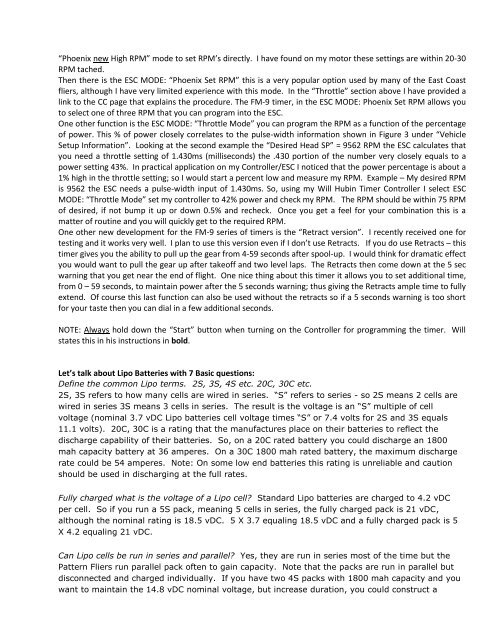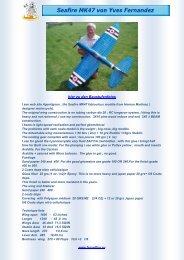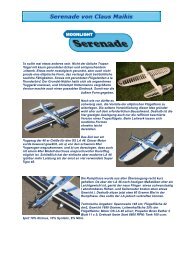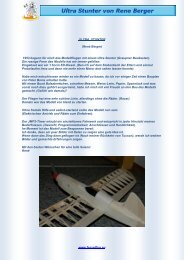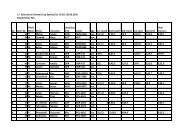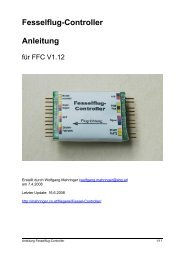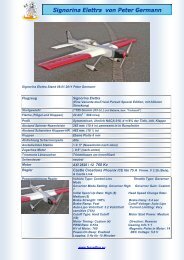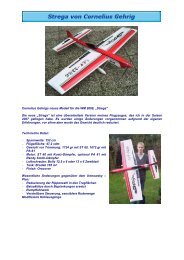Download this Article as PDF-File
Download this Article as PDF-File
Download this Article as PDF-File
Create successful ePaper yourself
Turn your PDF publications into a flip-book with our unique Google optimized e-Paper software.
“Phoenix new High RPM” mode to set RPM’s directly. I have found on my motor these settings are within 20-30<br />
RPM tached.<br />
Then there is the ESC MODE: “Phoenix Set RPM” <strong>this</strong> is a very popular option used by many of the E<strong>as</strong>t Co<strong>as</strong>t<br />
fliers, although I have very limited experience with <strong>this</strong> mode. In the “Throttle” section above I have provided a<br />
link to the CC page that explains the procedure. The FM-9 timer, in the ESC MODE: Phoenix Set RPM allows you<br />
to select one of three RPM that you can program into the ESC.<br />
One other function is the ESC MODE: “Throttle Mode” you can program the RPM <strong>as</strong> a function of the percentage<br />
of power. This % of power closely correlates to the pulse-width information shown in Figure 3 under “Vehicle<br />
Setup Information”. Looking at the second example the “Desired Head SP” = 9562 RPM the ESC calculates that<br />
you need a throttle setting of 1.430ms (milliseconds) the .430 portion of the number very closely equals to a<br />
power setting 43%. In practical application on my Controller/ESC I noticed that the power percentage is about a<br />
1% high in the throttle setting; so I would start a percent low and me<strong>as</strong>ure my RPM. Example – My desired RPM<br />
is 9562 the ESC needs a pulse-width input of 1.430ms. So, using my Will Hubin Timer Controller I select ESC<br />
MODE: “Throttle Mode” set my controller to 42% power and check my RPM. The RPM should be within 75 RPM<br />
of desired, if not bump it up or down 0.5% and recheck. Once you get a feel for your combination <strong>this</strong> is a<br />
matter of routine and you will quickly get to the required RPM.<br />
One other new development for the FM-9 series of timers is the “Retract version”. I recently received one for<br />
testing and it works very well. I plan to use <strong>this</strong> version even if I don’t use Retracts. If you do use Retracts – <strong>this</strong><br />
timer gives you the ability to pull up the gear from 4-59 seconds after spool-up. I would think for dramatic effect<br />
you would want to pull the gear up after takeoff and two level laps. The Retracts then come down at the 5 sec<br />
warning that you get near the end of flight. One nice thing about <strong>this</strong> timer it allows you to set additional time,<br />
from 0 – 59 seconds, to maintain power after the 5 seconds warning; thus giving the Retracts ample time to fully<br />
extend. Of course <strong>this</strong> l<strong>as</strong>t function can also be used without the retracts so if a 5 seconds warning is too short<br />
for your t<strong>as</strong>te then you can dial in a few additional seconds.<br />
NOTE: Always hold down the “Start” button when turning on the Controller for programming the timer. Will<br />
states <strong>this</strong> in his instructions in bold.<br />
Let’s talk about Lipo Batteries with 7 B<strong>as</strong>ic questions:<br />
Define the common Lipo terms. 2S, 3S, 4S etc. 20C, 30C etc.<br />
2S, 3S refers to how many cells are wired in series. “S” refers to series - so 2S means 2 cells are<br />
wired in series 3S means 3 cells in series. The result is the voltage is an “S” multiple of cell<br />
voltage (nominal 3.7 vDC Lipo batteries cell voltage times “S” or 7.4 volts for 2S and 3S equals<br />
11.1 volts). 20C, 30C is a rating that the manufactures place on their batteries to reflect the<br />
discharge capability of their batteries. So, on a 20C rated battery you could discharge an 1800<br />
mah capacity battery at 36 amperes. On a 30C 1800 mah rated battery, the maximum discharge<br />
rate could be 54 amperes. Note: On some low end batteries <strong>this</strong> rating is unreliable and caution<br />
should be used in discharging at the full rates.<br />
Fully charged what is the voltage of a Lipo cell Standard Lipo batteries are charged to 4.2 vDC<br />
per cell. So if you run a 5S pack, meaning 5 cells in series, the fully charged pack is 21 vDC,<br />
although the nominal rating is 18.5 vDC. 5 X 3.7 equaling 18.5 vDC and a fully charged pack is 5<br />
X 4.2 equaling 21 vDC.<br />
Can Lipo cells be run in series and parallel Yes, they are run in series most of the time but the<br />
Pattern Fliers run parallel pack often to gain capacity. Note that the packs are run in parallel but<br />
disconnected and charged individually. If you have two 4S packs with 1800 mah capacity and you<br />
want to maintain the 14.8 vDC nominal voltage, but incre<strong>as</strong>e duration, you could construct a


